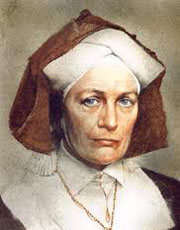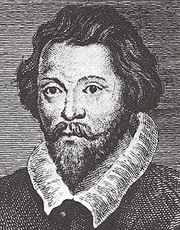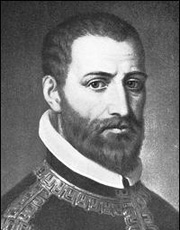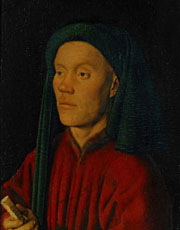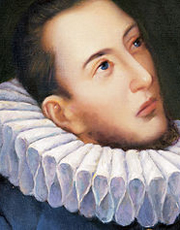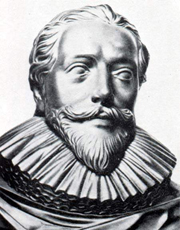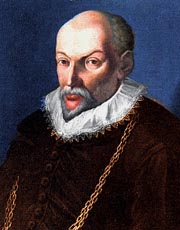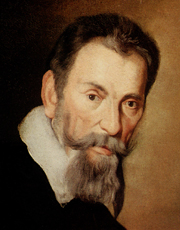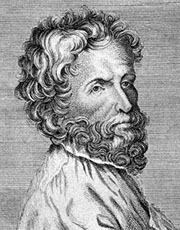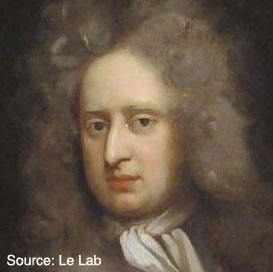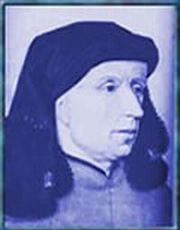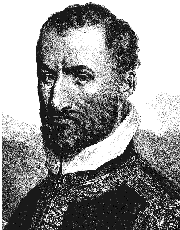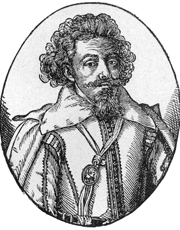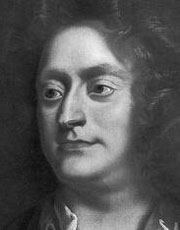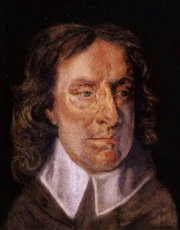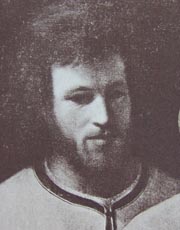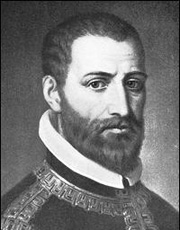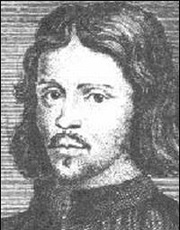In Celebration of the Human Voice - The Essential Musical Instrument
Home | Doo Wop | Barbershop | World | Contemporary | Christian | Vocal Jazz | Choral | Christmas | Instructional | Arrangements
Classical | Opera | Musicals | Personality | Young Singers | Disney | Videos | Songs | The Artists

Early Music Choral Composers
Choral music is one of the earlist forms of music and the composers of this music were real pioneers in the concept of notated and arranged voices.
![]() Composers - Early Music | Classical | 20th Century | Modern
Composers - Early Music | Classical | 20th Century | Modern
Displaying 1 - 21 of 21 items.
Hildegard von Bingen
Hildegard of Bingen began having visions as a child, but it wasn't until she was in her forties that her revelations in Christianity made her turn to composing. She founded convents and wrote plays, liturgies and hymns in praise of saints. Incredibly prolific, she was also considered a healer and early theologian and she was venerated in the church. Her compositions continue to be performed and recorded today.
Antoine Busnoys
French composer. Nothing certain is known about his origins or early training. By 1461 he was resident in Tours as a chaplain at the cathedral. In 1465 he was in charge of the choristers first at the collegiate church of St Martin in Tours (where his senior colleagues included Johannes Ockeghem ), then at St Hilaire-le-Grand in Poitiers. By 1467 he had moved into the service of the Burgundian court, and he became an official member of the chapel staff in 1470 . This position involved extensive travel in northern France and the Low Countries, both in peacetime and during military campaigns. The last payments to him occur in 1483 , after which his biography is again obscure.
Busnois is famous above all for his many polyphonic chansons, sophisticated works that reflect not only the Burgundian milieu but also the French royal court circle in which he moved during his years at Tours. Some of their poetic texts are almost certainly his own work. Fewer sacred works by him survive, but they are of high quality and often ingenious construction. One motet, Anthoni usque limina, is composed round a tenor line that invokes the tolling of a bell; another, the non-religious In hydraulis ( c. 1467 ), pays tribute to Ockeghem in both words and music. Busnois was among the first in a long line of composers to write a mass based on L'Homme arme, a melody thought to have had symbolic meaning to the Burgundian dukes.
William Byrd
William Byrd (1540? - July 4, 1623) was the most celebrated of early English composers. His entire life was marked by contradictions; as a true Renaissance man, he did not fit easily into categories. He lived well into the seventeenth century without writing songs in the new Baroque fashion, but his superbly constructed keyboard works marked the beginning of the Baroque organ and harpsichord style. Although he was nominally an Anglican court composer for much of his life, he spent his last years composing for the Roman liturgy, and died in relative obscurity. In the anti-Catholic frenzy following the 1605 Gunpowder Plot, some of his music was banned in England under penalty of imprisonment; some of it-such as the Short Service-has been sung in English cathedrals uninterrupted for the past four centuries.
Josquin Desprez
Josquin Des Prez was one of the most influential and widely regarded composers in the history of Western music, so famous that he is known merely by his first name. Josquin was apparently born in the Duchy of Burgundy, in modern Belgium. He spent a large portion of his middle years in various Italian cities as a highly sought master of music, and then retired to Conde (in Northeast France) late in his life. Josquin's extended sojourns in Italy allowed him not only to spread the Northern polyphonic style there, but to pick up some of the Southern vitality noticeable in many of his secular works. However, his extended works are always marked by a subtlety and serenity characteristic of the Franco-Flemish school.
Guillaume Dufay
Guillaume Dufay was a Franco-Flemish composer and music theorist of the early Renaissance. As the central figure in the Burgundian School, he was the most famous and influential composer in Europe in the mid-15th century, and can be considered as the founding member of the Netherlands school which dominated European music for the next 150 years.
From the evidence of his will, Guillaume Dufay was probably born in Beersel, in the vicinity of Brussels. He was the illegitimate child of an unknown priest and a woman named Marie Du Fayt. Marie moved with her son to Cambrai early in his life, staying with a relative who was a canon of the cathedral there. Soon Dufay's musical gifts were noticed by the cathedral authorities, who evidently gave him a thorough training in music; he studied with Rogier de Hesdin during the summer of 1409, and he was listed as a choirboy in the cathedral from 1409 to 1412. During those years he studied with Nicolas Malin, and the authorities must have been impressed with the boy's gifts because they gave him his own copy of Villedieu's Doctrinale in 1411, a highly unusual event for one so young. In June 1414, at the age of only 16, he had already been given a benefice as chaplain at St. Gery, immediately adjacent to Cambrai. Later that year he probably went to the Council of Konstanz, staying possibly until 1418, at which time he returned to Cambrai.
Carlo Gesualdo
Born into the Italian nobility, Don Carlo Gesualdo developed an early and passionate interest in music. Though recognized as a dynamic composer who was far ahead of his time, Gesualdo's brilliance as a musical talent has been overshadowed by his violent personal life. After discovering his wife (and first cousin), the lovely and charming Maria d'Avalos, in the arms of the Duke of Andria, Gesualdo flew into a jealous rage and stabbed them both to death. He fled to northern Italy to avoid persecution, and was never tried nor punished for his crimes. His second wife was Eleonora d'Este, a highborn lady whose powerful family included the Dukes of Ferrara and Modena. Gesualdo treated his second bride as dismally as his first, and his death in 1613 was rumored to have been arranged by the vengeful Eleonora. The incredible chromatic harmony and wild contrasts in his music seem to be a reflection of Gesualdo's temptestuous personality. His mania for constantly composing music may have been a sign of melomania.
Orlando Gibbons
Orlando Gibbons, born in Oxford, came of a musical family, like his near contemporary, Thomas Tomkins. His father William (c. 1540-1595) was appointed one of the waits at Cambridge in 1567, a fact which, at this time, would indicate that he was a singer or instrumentalist, or both. Orlando's brothers Edward (c. 1570-c. 1650) and Ellis (1573-1603) are each represented by a small number of surviving works. Christopher (1615-1676), his son, was to achieve an estimable position as a composer of the baroque period. As might be expected, some confusion in attributions has resulted from the fact that several members of the family composed. Orlando, in 1596, entered the choir at King's College, Cambridge. He became organist of the Chapel Royal in 1605, and in 1606 took the degree of Mus. Bac. at Cambridge. On May 17, 1622, the Chair of History at Oxford was founded by William Camden (1551-1623), the antiquary and historian, and at his request the degree of Mus. Doc. was conferred upon Gibbons on this occasion. In 1623, Gibbons became organist of Westminster Abbey, and as such he officiated at James I's funeral in 1625. Soon thereafter he himself died suddenly at Canterbury where, with the rest of the Chapel Royal, he had gone in attendance upon Charles I; the new king was waiting there to leave for Dover and meet his bride Henrietta Maria upon her arrival from France.
Orlando Lassus
Orlando di Lasso was born in Mons in the province of Hainaut, in what is today Belgium. Information about his early years is scanty, although some uncorroborated stories have survived, the most famous of which is that he was kidnapped three times because of the singular beauty of his singing voice. At the age of 12 he left the Low Countries with Ferrante Gonzaga and went to Mantua, Sicily, and later Milan (from 1547 to 1549). While in Milan he made the acquaintance of the madrigalist Hoste da Reggio, an influence which was formative on his early musical style.
He then worked as a singer and a composer for Constantino Castrioto in Naples in the early 1550s, and his first works are presumed to date from this time. Next he moved to Rome, where he worked for the Archduke of Florence, who maintained a household there; and in 1553, he became maestro di cappella (chorus leader) of the Basilica di San Giovanni in Laterano in Rome, a spectacularly prestigious post for a man only 21 years old, but he stayed there only for a year (Palestrina took this post a year later, in 1555).
Claudio Monteverdi
In Claudio Monteverdi's lifetime, Western art music stood at a crossroads. There were two major types of vocal music at that time: popular songs on mundane themes and music intended to accompany church services. The former group included fairly simple settings for solo voice and madrigals, which set music for two or more independent voice parts. Church music had evolved by the early 16th century into an elaborate polyphony. Josquin Desprez and Giovanni Pierluigi da Palestrina were the foremost composers in this style, in which four or more parts develop musical lines from the tunes to popular and even bawdy songs. Each of the four or more parts wove these tunes together in a dense counterpoint, with no part assigned a primary melodic or harmonic function. The music displayed the consummate skills of their composers, and sounded breathtakingly beautiful when done by a capable choir. However, by the late 16th century, this type of contrapuntal music had become too difficult for most church choirs to sing and most parishioners to understand.
Cristobal de Morales
Almost all of his music is sacred, and all of it is vocal, though instruments may have been used in an accompanying role in performance. He wrote many masses, some of spectacular difficulty, most likely written for the expert papal choir; he wrote over 100 motets; and he wrote 18 settings of the Magnificat, and at least five settings of the Lamentations of Jeremiah (one of which survives from a single manuscript in Mexico). The Magnificats alone set him apart from other composers of the time, and they are the portion of his work most often performed today. Stylistically, his music has much in common with other middle Renaissance work of the Iberian peninsula, for example a preference for harmony heard as functional by the modern ear (root motions of fourths or fifths being somewhat more common than in, for example, Gombert or Palestrina), and a free use of harmonic cross-relations rather like one hears in English music of the time, for example in Thomas Tallis. Some unique characteristics of his style include the rhythmic freedom, such as his use of occasional three-against-four polyrhythms, and cross-rhythms where a voice sings in a rhythm following the text but ignoring the meter prevailing in other voices. Late in life he wrote in a sober, heavily homophonic style, but all through his life he was a careful craftsman who considered the expression and understandability of the text to be the highest artistic goal.
Thomas Morley
Thomas Morley was an English composer, theorist, singer and organist of the Renaissance. He was one of the foremost members of the English Madrigal School. Referring to the strong Italian influence on the English madrigal, The New Grove Dictionary of Music and Musicians states that Morley was "chiefly responsible for grafting the Italian shoot on to the native stock and initiating the curiously brief but brilliant flowering of the madrigal that constitutes one of the most colourful episodes in the history of English music."
Living in London at the same time as Shakespeare, Morley was the most famous composer of secular music in Elizabethan England. He and Robert Johnson are the composers of the only surviving contemporary settings of verse by Shakespeare.
Morley was active in church music as a singer, composer and organist at St Paul's Cathedral. He was also involved in music publishing. From 1598 up to his death he held a printing patent (a type of monopoly). He used the monopoly in partnership with professional music printers such as Thomas East.
Johannes Ockeghem
Although often thought to be Flemish, Ockeghem was born in Saint-Ghislain, in the provence of Hainaut (now part of modern Belgium), part of the Duchy of Burgundy. Like many composers in this period, he started his musical career as chorister: in his case, in the Notre Dame in Antwerp. Around 1452 he moved to Paris where he served as maestro di cappella to the French court, as well as becoming treasurer of the St. Martin cathedral in Tours.
Very few of his works have survived: some 14 masses, 10 motets, some 25 chansons, and a single requiem. This Missa pro Defunctis is the earliest surviving example of a polyphonic requiem mass.
A strong influence on Josquin Des Prez, Ockeghem was famous throughout Europe for his expressive music and his technical mastery. His technical prowess is demonstrated most clearly in the astonishing Missa Prolationem, composed entirely in canonical style, and his no less astonishing 36(!) part canon Deo Gratias. - but even these technique-oriented masterpieces demonstrate his insightful use of vocal ranges and unique expressive tonal language. Being a renowned bass singer himself, certainly his use of complex bass lines sets him apart from the other composers in the Dutch Schools.
To commemorate his death, Josquin Des Prez composed Nymphes des Bois on a poem by Molinet.
Giovanni Pierluigi Palestrina
He was nicknamed Il Prenestino. He had a tremendous influence on the development of Roman Catholic church music.
He went to Rome at the age of fourteen to sixteen and is supposed to have studied under Claude Goudimel. In 1544-51 he was organist of the principal church of his native city (St. Agapito, Palestrina), and in the latter year became maestro di cappella at Cappella Giulia in Rome. By his first compositions -- three masses dedicated to Pope Julius III (previously the Bishop of Palestrina) -- he made so favorable an impression that he was appointed musical director of the Julian chapel. He held similar positions at various chapels and churches in Rome until his death (notably St. John Lateran (1555-60) and St. Maria Maggiore (1561-6)); and by his compositions, which are very numerous -- masses, motets, hymns, and others, of which only one-half have been published -- he produced a complete revolution in the history of church music, altering the existing chants in line with the recommendations of the Council of Trent. The Missa Papae Marcelli is generally counted among his greatest masterpieces.
Michael Praetorius
Michael Praetorius was the son of Michael Schultze (Praetorius being a Latinization of the name). At an early age Praetorius attended the University of Frankfurt a. O., his brother supporting him.
When his brother died, Praetorius became organist at Frankfurt and later held the same post at Luneburg. In this latter town Pratorius began his career as Kapellmeieter. In 1604 he entered the service of the Duke of Brunswick at Wolfenbuttel, first as organist, later as "kapellmeister" and secretary. He was appointed honorary prior of the Ringelheim Monastery near Goslar, but without compulsion to reside there.
Praetorius had become famous as composer of church music, among which should be mentioned the mammoth edition of over twelve hundred songs. He began to write a complete encyclopedia of the art and practice of music, of which he finished three volumes with the title Syntagma Musicum. The second volume of this work is the most elaborate and valuable of all treatises on instruments and instrumental music in the 16th century. It is considered one of the most remarkable examples of musical scholarship in existance. Among his other titles were Musae Sioniae published in nine parts and Hymnodia Sionae. He ranks high as a writer and also as a composer of church melodies.
Henry Purcell
Born in 1659, Henry Purcell was the finest and most original composer of his day. Though he was to live a very short life (he died in 1695) he was able to enjoy and make full use of the renewed flowering of music after the Restoration of the Monarchy.
As the son of a musician at Court, a chorister at the Chapel Royal, and the holder of continuing royal appointments until his death, Purcell worked in Westminster for three different Kings over twenty-five years.
In the Chapel Royal young Purcell studied with Dr. John Blow. Dr. Burney, the eighteenth century historian, is amusingly skeptical on this point: "..... he had a few lessons from Dr. Blow, which were sufficient to cancel all the instructions he had received from other masters, and to occasion the boast inscribed on the tomb-stone of Blow, that he had been 'Master to the famous Mr. Henry Purcell'." Legend has it that when, in 1679, Purcell succeeded Dr. Blow as organist of Westminster Abbey, the elder musician stepped aside in recognition of the greater genius, and it is true that on Purcell's death in 1695 Blow returned to the post, and would write a noble Ode on the Death of Purcell.
Jan Sweelinck
Jan Pieterszoon Sweelinck (Swelinck, Zwelinck, Sweeling, Sweelingh, Sweling, Swelingh) was a Dutch composer, organist, and pedagogue whose work straddled the end of the Renaissance and beginning of the Baroque eras.
Many of Jan Pieterszoon Sweelinck's family were musicians - principally organists. He was the elder son of Peter Swybbertszdon and Elske Sweeling, he adopted his mother's family name. The assertion that he studied in Venice with Zarlino, the famous composer and theorist, is not supported by surviving evidence. His only known teachers besides his father were Jacob Buyck, pastor at the Oude Kerk, Amsterdam, and Jan Willemszoon Lossy, a counter-tenor and shawm player at Haarlem, who taught him not organ but composition. By 1580, and possibly as early as 1577, he was organist at the Oude Kerk; his duties there were probably to provide an hour of music twice daily in the church. He became famous for his brilliant improvisations at the organ and harpsichord. From this time onward he left Amsterdam only to inspect new organs and advise on repairs and restorations.
Thomas Tallis
Little is known about Tallis's early life, but there seems to be agreement that he was born in the early 16th century, toward the close of the reign of Henry VII. His first known appointment to a musical position was as organist of Dover Priory in 1530-31, a Benedictine priory at Dover (now Dover College) in 1532. His career took him to London, then (probably in the autumn of 1538) to the Augustinian abbey of Holy Cross at Waltham until the abbey was dissolved in 1540.
composed and performed for Henry VIII, Edward VI (1547-1553), Queen Mary (1553-1558), and Queen Elizabeth I (1558 until Tallis died in 1585). Throughout his service to successive monarchs as organist and composer, Tallis avoided the religious controversies that raged around him, though, like William Byrd, he stayed an "unreformed Roman Catholic." Tallis was capable of switching the style of his compositions to suit the different monarchs' vastly different demands. Among other important composers of the time, including Christopher Tye and Robert White, Tallis stood out. Walker observes, "He had more versatility of style than either, and his general handling of his material was more consistently easy and certain."
Thomas Tomkins
Tomkins composed over one hundred anthems contained in "Musica Deo sacra," numerous madrigals of which "When David heard" is considered to be one of the most powerful settings for this text, fifty keyboard pieces and some unique galliards, pavans and fantasias for the viol family ensemble. Byrd was probably one of Tomkins teachers. He served as an organist for Worcester Cathedral and was a Gentleman in Ordinary of the Chapel Royal by 1620. More than likely he was present at the coronation of James I but he definitely composed music for the coronation of Charles I. He was an admired successor to Byrd though his contemporary compositions were often criticized for being anachronistic.
Philippe Verdelot
Philippe Verdelot (1480 to 1485 - c.1530 to 1532?) was a French composer of the Renaissance, who spent most of his life in Italy. He is commonly considered to be the father of the Italian madrigal, and certainly was one of its earliest and most prolific composers; in addition he was prominent in the musical life of Florence during the period after the recapture of the city by the Medici from the followers of Girolamo Savonarola.
Verdelot was born Les Loges, Seine-et-Marne, France. Details of his early life are obscure. He probably came to Italy at an early age, spending the first decade or two of the 16th century at some cities in northern Italy, most likely including Venice. A painting of 1511, described by Vasari but never positively identified, is believed by many musicologists to show Verdelot in Venice with an Italian singer.
Tomas Luis Victoria
The dominating figure of sixteenth century Spanish music, Tomas Luis de Victoria was born in Avila. He was sent to Rome to study, possibly for a time under Palestrina during the latter's years at the Roman Seminary. In 1571 he succeeded Palestrina there as choirmaster, a post he also subsequently occupied at the Jesuit Order's German College. Later he became active as a priest, working at St. Girolamo della Carita. Following his return to Spain in 1585, Victoria served the Empress Maria and her daughter as teacher, organist, and choirmaster until his death in 1611.
Thomas Weelkes
Weelkes was baptised in the little village church of Elsted in Sussex on 25 October 1576. It has been suggested that his father was John Weeke, rector of Elsted, although there is no documentary evidence of the relationship. In 1597 his first volume of madrigals was published, the preface noting that he was a very young man when they were written; this helps to fix the date of his birth to somewhere in the middle of the 1570s. Early in his life he was in service at the house of the courtier Edward Darcye. At the end of 1598, at the probable age of 22, Weelkes was appointed organist at Winchester College, where he remained for two or three years, receiving the salary of 13s 4d per quarter. His remuneration included board and lodging.
During his Winchester period, Weelkes composed a further two volumes of madrigals (1598, 1600). He obtained his B. Mus. Degree from New College, Oxford in 1602, and moved to Chichester to take up the position of organist and informator choristarum (instructor of the choristers) at the Cathedral at some time between October 1601 and October 1602. He was also given a lay clerkship at the Cathedral, being paid 15 2s 4d annually alongside his board, lodging and other amenities. The following year he married Elizabeth Sandham, from a wealthy local family. They had three children and it was rumored that Elizabeth was already pregnant at the time of the marriage.
Select a Category |
Want to Sing? - Find a Chorus Near You
List of Choruses by State | List of Choruses by City

